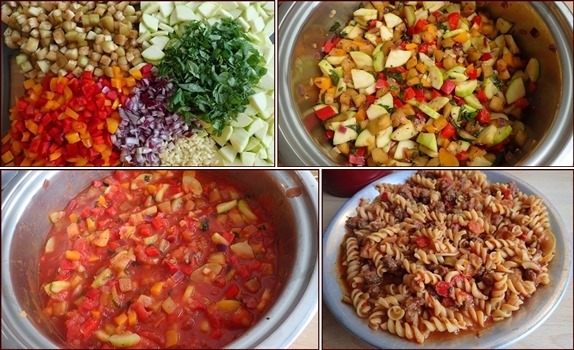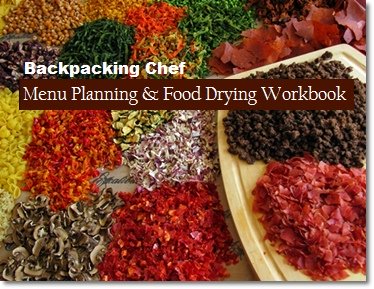How to Make Ratatouille for Home & Trail
Whether you’re dining in by candlelight, or under the stars by a campfire, this article shows how to make ratatouille like the best French chefs from Paris to the Pyrenees. The recipe uses traditional ratatouille ingredients including eggplant, zucchini, bell peppers, onions, garlic, tomatoes and fresh basil. I make this ratatouille recipe on the saucy side, so it’s perfect with pasta.
After I cover how to make ratatouille, I’ll show you how to dehydrate it and make meals for your backpacking and camping adventures.
Table of Contents
How to Make Ratatouille
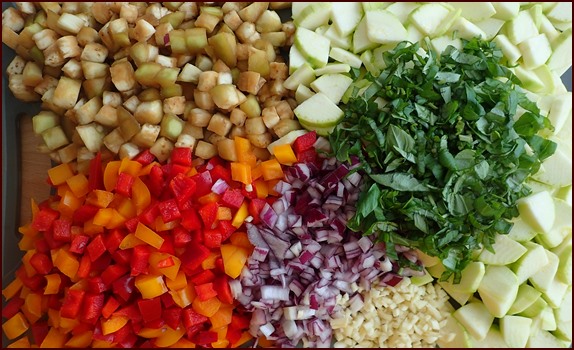
Photo: Eggplant, zucchinis, bell peppers, onions, garlic and basil.
Servings: 4
Ingredients:
- 1 eggplant, medium (280−300 g)
- 2 zucchinis, medium (300−325 g)
- 2 bell peppers, colorful (280−300 g)
- 2 onions, small (80−100 g)
- 3 cloves garlic
- 1 cup fresh basil
- 3 cans diced tomatoes (400 g each) or fresh equivalent. *
- 3 bay leaves
- 2 tsp. Herbs de Provence
- 1 tsp. fennel seeds **
- 1 tsp. salt
- ⅛ tsp. ground pepper
* Three cans of diced tomatoes will make a saucy ratatouille which is perfect for serving over pasta. If you want to serve the ratatouille as a stand-alone meal, use only one can of diced tomatoes.
** Fennel seeds are an important flavor ingredient for ratatouille. Be sure to include them.
Preparing Ratatouille Ingredients:
If you don’t plan on dehydrating the ratatouille, cut the vegetables into larger pieces. If dehydrating, it’s better to cut the vegetables into smaller pieces as described below so they dry efficiently.
- Peel eggplant and cut into ½-inch cubes. *
- Peel zucchinis, cut them into quarters lengthwise, and then cut crosswise into ¼-inch slices.
- Dice peppers and onions; mince garlic.
- Chop fresh basil leaves.
- Measure dry ingredients and combine them in a small bowl.
* You may squeeze half-inch slices of eggplant between paper towels before cutting the slices into cubes. This will remove some of the bitter juices. I actually like the full flavor of eggplant and enjoy the bitter notes.
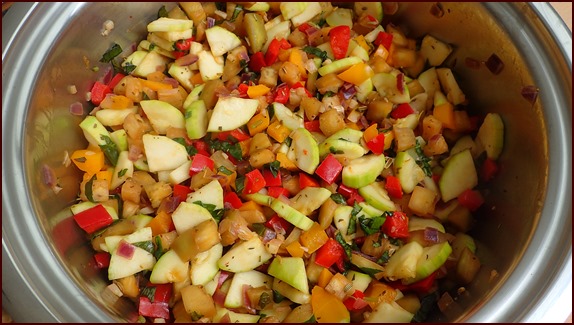
Photo: Ratatouille vegetables cooking in pot before diced tomatoes were added.
How to Cook Ratatouille
I use a 9” x 4” stew pot to make ratatouille, but you can also cook it in a deep frying pan.
Add two teaspoons of cooking oil to pot on medium-high temperature.
Cook onions for five minutes, then add peppers and garlic, cooking for another five minutes.
Add eggplant, zucchini and all dry ingredients. Continue cooking while stirring for another five minutes.
Add chopped basil and diced tomatoes. Increase temperature until ratatouille is bubbling, then reduce heat to medium, keeping a light simmer for about 15 minutes.
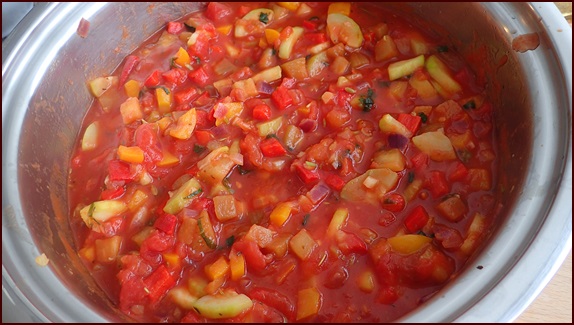
Photo: Cooked ratatouille.
Serve ratatouille over pasta of choice, such as rotini or linguine.
Ratatouille & Pasta could be the star meal of your next outdoor adventure. It’s easy to dehydrate as described below, and it rehydrates at your campsite in minutes with boiled water.
How to Dehydrate Ratatouille
This recipe yields between seven and eight cups of cooked ratatouille (1800 ml) and can be dried on six Cosori dehydrator trays.
Photo: Silicone dehydrator tray holding 1¼ cups of ratatouille.
Spread 1¼ to 1½ cups of ratatouille on each of six nonstick dehydrator trays or sheets. Silicone trays with raised edges work well. Don’t overload the trays, as that will increase the drying time.
Set dehydrator to 135°F (57°C) for 12 hours.
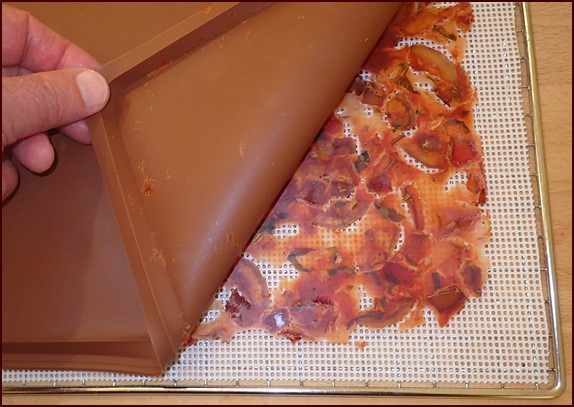
Photo: Flipping and peeling silicone tray off.
When the ratatouille is substantially dry after about 10 hours, flip it over onto a nonstick mesh sheet and peel off the nonstick tray. This ensures that the ratatouille will dry completely on the bottom side.
Photo: Dehydrated ratatouille on silicone mesh sheet.
Storing Dehydrated Ratatouille
Dehydrated ratatouille will be almost crumbly, and you can easily tear it into smaller pieces.
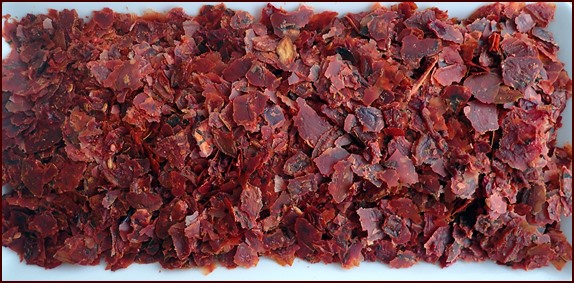
For trail use, Ziploc bags are fine for short trips. Consider vacuum sealing for longer trips.
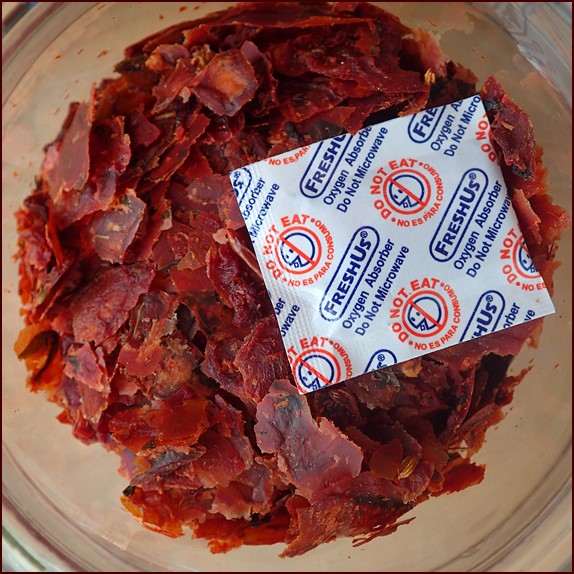
For home storage, put dried ratatouille in airtight container with an oxygen absorber.
Another way is to store it in mason jars that you remove the oxygen from using a jar vacuum-sealing accessory.
Shop Amazon:
Ratatouille Recipe for the Trail
Here’s where the extra-saucy feature of this ratatouille recipe comes into play. For a satisfying and delicious backpacking meal, combine the ratatouille with pasta and ground beef or chicken.
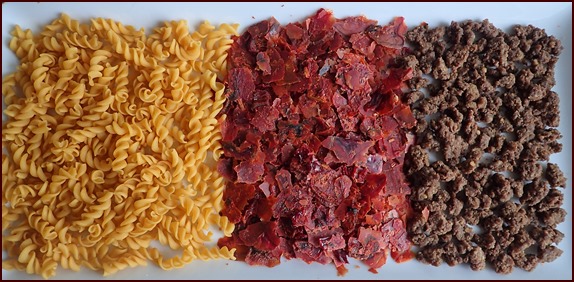
Photo: Rotini pasta, ratatouille and ground beef.
Servings: 1
Ingredients:
- ¾ cup dehydrated rotini (50 g)
- ½ cup dehydrated ratatouille (30 g)
- ¼ cup dehydrated ground beef or chicken (30 g)
- 1½ cups water to rehydrate (355 ml)
Pack ingredients in a Ziploc bag for transport. Consider vacuum-sealing for long trips.
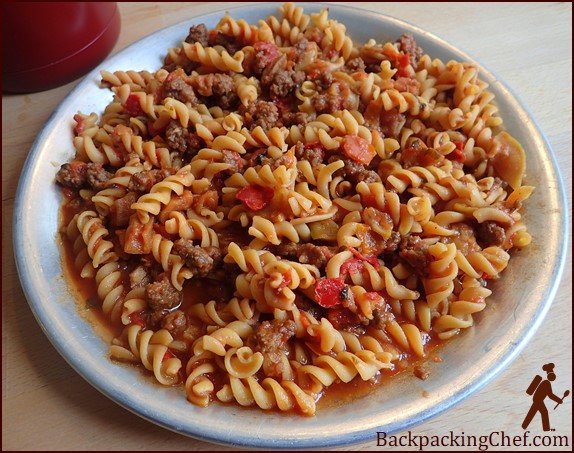
Photo: Rehydrated Rotini & Beef with Ratatouille.
On the Trail:
Place ingredients in pot with water. Let soak for five minutes, then light stove. Bring to a boil for one minute, then transfer pot to an insulating pot cozy for 15−20 minutes.
Alternatively, add boiled water to ingredients in a separate container such as a Mylar bag. Zip closed, insulate bag, and wait 20 minutes before serving.
Thermos Ratatouille Meal
Thermos meals are great for road trips, camping, and work lunches. We also carry a thermos meal with us for lunch on our day hikes. The ingredient quantities below will fill one 24-ounce capacity thermos food jar which makes a large serving for one hungry hiker or two people to share.
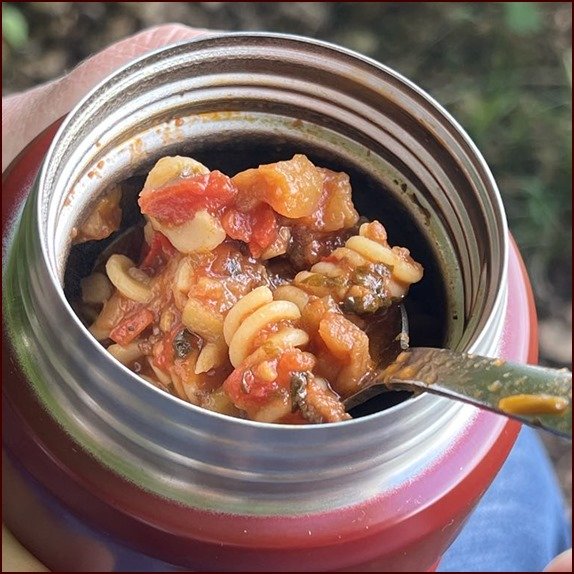
Ingredients:
- 1 cup dehydrated rotini (75 g)
- ¾ cup dehydrated ratatouille (45 g)
- ⅓ cup dehydrated ground beef or chicken (40 g)
- 2 cups water to rehydrate (473 ml)
Before You Head Out:
Place ingredients in thermos. Add boiled water, stir, and put lid back on. Wait 20 minutes up to several hours to serve.
Thermos Pasta Tip:
Pasta gets soft when it sits in a thermos for several hours. It still tastes good, but if you want perfect al dente pasta, pack the pasta separately and add it to the thermos 20 minutes before serving. Add the full amount of boiled water to the ratatouille and ground beef before you head out.
Shop Amazon: Thermos Food Jar.
Dehydrator Accessories
Shop Amazon for the Cosori dehydrator and accessories used for dehydrating ratatouille on this page. The silicone trays and silicone mesh sheets are flexible, truly nonstick, and are very easy to clean. Mesh sheets can be cut to size with scissors. These dehydrator accessories will ensure you get excellent results for all your food drying projects.

Left: Silicone Dehydrator Trays with Raised Edges, 11.8" x 10.8", 6-Pack
Middle: Cosori Dehydrator, Stainless Steel, 6-Trays
Right: Silicone Mesh Dehydrator Sheets, 14” x 14”, 12-Pack
Disclosure: As an Amazon Associate, Backpacking Chef earns from qualifying purchases. Thank you!
Storage Accessories
Vacuum Sealer Accessory for Mason Jars
Explore More…
How to Make Tomato Sauce Leather
Share this page with friends on social media.
Free E-book & Newsletter
Free with Trail Bytes subscription.
Dehydrating Food from A–Z

